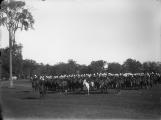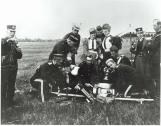1
8th Hussars Regimental Flag sewn in Rothesay NB, October 1885October 1885
Rothesay, New Brunswick, Canada
 Credits:
Credits:Association of the 8th Canadian Hussars (Princess Louise's) Inc
Howe, Douglas,The 8th Hussars, A History of the Regiment
Ganong, AT, A Historical Outline of the Regiment
2
8th Hussar Band at summer camp1885
Sussex, New Brunswick, Canada
 Credits:
Credits:New Brunswick Provincial Archives - P33-89 / 8th Princess Louise's New Brunswick Hussars Band
Association of the 8th Canadian Hussars (Princess Louise's) Inc
Ganong, AT, A Historical Outline of the Regiment
3
The 8th Hussars on Mounted Parade1888
Sussex, New Brunswick, Canada
 Credits:
Credits:New Brunswick Provincial Archives - P33-90 / 8th Princess Louise's New Brunswick Hussars on horseback - Camp Sussex
Ganong, AT, A Historical Outline of the Regiment
Crook and Marteinson, A Pictorial History of the 8th Canadian Hussars (Princess Louise's)
Howe, Douglas,The 8th Hussars, A History of the Regiment
4
8th Hussars Officers Formal Photograph1888
Sussex, New Brunswick, Canada
 Credits:
Credits:New Brunswick Provincial Archives - P33-91 / 8th Princess Louise's New Brunswick Hussars (late 1880s) - Camp Sussex
Howe, Douglas,The 8th Hussars, A History of the Regiment
5
First Aid Training1890
Sussex, New Brunswick, Canada
 Credits:
Credits:Association of the 8th Canadian Hussars (Princess Louise's) Inc
Howe, Douglas,The 8th Hussars, A History of the Regiment
Crook and Marteinson, A Pictorial History of the 8th Canadian Hussars (Princess Louise's)
6
During this period, the method and procedures for operating large concentrations of troop training in very short periods of time was being developed although most years were plagued by chronic shortages of funds and thus cancelled training for all or parts of each unit. Commanding Officers became used to rotating their various companies and squadrons into the camps on alternate years.
Equipment shortages were chronic. The infantry were short on boots and rucksacks and it was noted the men had no method of carrying their daily rations with them. It was noted that the cavalry saddles were of poor quality and this was impacting the daily training of the troops due to higher than usual care that must be afforded to their horses.
All however was not detrimental to the Camp Sussex development. Records show that the 1879 camp was held at Kelties Farm in Sussex and this site would be used for the foreseeable future. A milestone for the cavalry regiment was achieved that year as they provided an escort in Saint John for Her highness Princess Louise and the His Excellency, The Governor General. From this meeting resulted the request to use her title in the name of the Regiment which was granted in due course.
The newly formed Rifle Association would distribute over $1100 in prizes at the annual rifle competition in1880 and ammunition was starting to be manufactured in Canada vice being supplied by British armament plants
In 1881 a full brigade camp with units from over the province was held in Sussex. This was to be the forerunner of Camp Sussex. The Governor General visited the camp and reported that he was satisfied with the training. A new unit was formed this year and they were to have impacts on Camp Sussex for many years to come. The Brighton Engineers were formed in Woodstock from one of the 67th Battalion companies. This unit was to achieve excellence in many areas of engineering over the next half century and continued in existence until 1960. During the toughest financial times the unit continued to flourish and at one time was only one of two engineer companies in existing in Canada, the other residing in Charlottetown PEI. This brigade camp also included three infantry battalions from Nova Scotia and three from Prince Edward Island. It was during this camp that a trend was starting to occur that would exist for a number of years. The Hussars actual built their own stables for the horses by collecting the money from the members of the Regiment, as no government monies existed for developing permanent structures for these camps.
From 1882 until 1890 brigade camps were held at various locations around the province: 1883- Sussex, 1884-Shediac, 1885-Fredericton, 1886-Sussex, 1887-St Andrews, 1888-Chatham, 1889- St Andrews, 1890 - Moncton. Local camps were held for units who could not afford to travel to the brigade camps and these were held in Sussex, Hampton and Rothesay on occasion. During these brigade and local camps, another trend was starting to occur as local populations were actively becoming involved in the social aspect of the camps. Bands that had been in existence for a number of years, continued to flourished and they provided local daily entertainment. Spectators to the camps were increasing yearly. At the Moncton camp, spectators were so numerous that they impeded the cavalry charge at the end of the exercise. Daily trains to the site had been run from as far away as Chatham and Saint John. The previous year it was noted that the town of Chatham provided so much hospitality that it could not all be accepted and taken part in. It was at the fall camp in Rothesay that the Hussars were presented with a flag sewn by the ladies of the community to acknowledge the Regiments presence in their community. This flag still exists today and is displayed in the 8th Hussars Arena in Sussex, NB.
However a common theme unfortunately surrounded most of these camps. Money was very scarce and most units could only train on alternative years, or they would send half of their members one year and half the next.
Fall camps were being established again and this was to run against the wishes of many of the soldiers as this time was necessary for harvesting and preparing for winter. This issue was to simmer for sometime. Since most of these soldiers were farmers and labourers, the best time for them to attend camps was in late June just prior to the start of the haying season.
In the midst of all these various camps, the 74th Battalion was to supply a full company to support a battalion training in Sussex in 1885 in preparation for a move west to suppress the Northwest Rebellion. During that summer over 1000 personnel from around the province were trained in Sussex. Hoever the swift suppression of the rebellion negated the need for these troops to move west and the conflict ended as they were completing thier training.
In 1891 the brigade camps were moved back to Sussex. The stables erected by the Hussars ten years earlier, had fallen into disrepair and so the Regiment gathered up the funds necessary and built anew. Also the Hussars in true cavalry fashion were starting to take on the role as the provider of most social events of these camps.
In 1892, the Brighton Engineer Company demonstrated a remarkable feat of engineering. On a two day period 450 trees were cut on the site and hand hewn for bridge timbers. On the following day, starting a 2:00 PM, they started construction of a 111 ft bridge over Trout Creek joining the camp to the town site. The entire bridge was finalized at 6:30 PM. What makes this feat even more outstanding was that the only tools allowed were 5 augers, 7 axes, 1 handsaw and 1 crosscut saw.